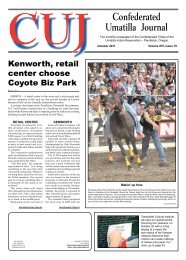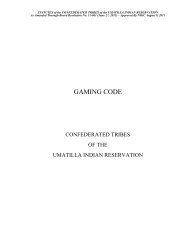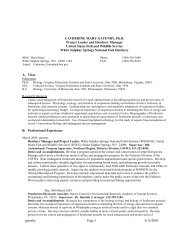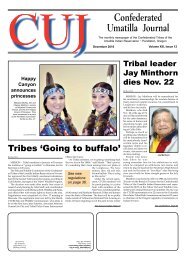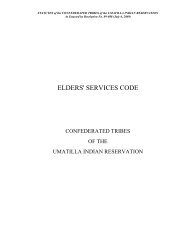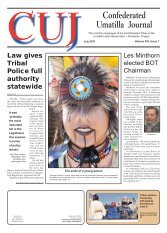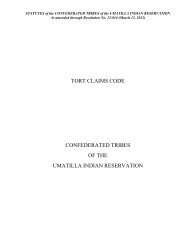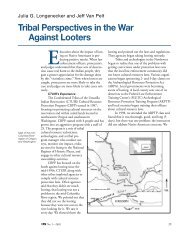November 2011 CUJ - Confederated Tribes of the Umatilla Indian ...
November 2011 CUJ - Confederated Tribes of the Umatilla Indian ...
November 2011 CUJ - Confederated Tribes of the Umatilla Indian ...
- No tags were found...
Create successful ePaper yourself
Turn your PDF publications into a flip-book with our unique Google optimized e-Paper software.
Tribal colleges hope to lure kids to hoopsBy MYERS REECE, Fla<strong>the</strong>ad BeaconKALISPELL, Mont. (AP) - On <strong>the</strong>Fort Belknap <strong>Indian</strong> Reservation, a landriddled with devastating poverty andperpetual unemployment, <strong>the</strong>re are noscholarships. Basketball is played, as <strong>the</strong>saying goes, for <strong>the</strong> love <strong>of</strong> <strong>the</strong> game.Fort Belknap’s Aaniiih Nakoda Collegeis one <strong>of</strong> five Montana tribal collegesto <strong>of</strong>ficially form basketball programswithin <strong>the</strong> last two years, joining SalishKootenai College on <strong>the</strong> Fla<strong>the</strong>ad <strong>Indian</strong>Reservation and <strong>the</strong> Crow Agency’s LittleBig Horn College.The o<strong>the</strong>rs are Stone Child College inBox Elder, Chief Dull Knife College inLame Deer, Blackfeet Community Collegein Browning and Fort Peck CommunityCollege in Poplar. Aaniiih Nakodais in Harlem.Now all seven <strong>of</strong> <strong>the</strong> state’s reservationcolleges have basketball programs,playing in a league called <strong>the</strong> MontanaTribal College Athletic Association. Theorganization was called <strong>the</strong> MontanaTribal College Basketball League lastyear, which was <strong>the</strong> organization’s first.The regular season begins in <strong>November</strong>and <strong>the</strong> league tournament is held inFebruary.While <strong>the</strong> tribal colleges have longhad loosely formed teams, <strong>the</strong> school’sathletic directors say <strong>the</strong> league gives<strong>the</strong> teams a real game schedule, a claimto legitimacy and, most importantly,an incentive to attract young American<strong>Indian</strong>s to college and keep <strong>the</strong>m <strong>the</strong>re.``It gets more students to our campusbecause <strong>Indian</strong> people love basketball,’’Gerald Stiffarm, league commissionerand Aaniiih Nakoda College’s athleticdirector, said. ``It’s just what makes <strong>Indian</strong>communities tick.’’Some <strong>of</strong> <strong>the</strong> greatest prep players toFind all yourNixyaawiiapparel...~ Celebrating 32 years in business ~Good luck to area teamsentering play<strong>of</strong>f time!Nixyaawii Letterman’s JacketsNixyaawii hooded sweatshirts in cardinal,gray and blackNixyaawii T-shirts in cardinal and grayNixyaawii hats (4 styles) and visorsNixyaawii beanies and stocking capsEagles muffler with “N” for NixyaawiiDean Fouquette’sever take <strong>the</strong> court in Montana have beenAmerican <strong>Indian</strong>s. The names border onlegendary in knowledgeable basketballcircles: Jonathan Takes Enemy, Elvis OldBull, Larry Pretty Weasel and J.R. Camel,to name a handful. Camel is an assistantcoach on <strong>the</strong> Salish Kootenai men’s team.But <strong>the</strong> transi t i o n o f f t h ereservation intocollege life hasbeen rocky fora number <strong>of</strong> <strong>the</strong>state’s top nativeplayers, if <strong>the</strong>yleft home at all.It is with this inmind that tribalc o l l e g e p r e s i -dents founded <strong>the</strong>league with threef u n d a m e n t a lgoals, accordingto Stiffarm: studentrecruitment,student retentionand developing ``<strong>the</strong> concept <strong>of</strong> <strong>the</strong> NativeAmerican-student athlete.’’The state’s tribal basketball teams aremade up <strong>of</strong> enrolled members <strong>of</strong> <strong>the</strong>irrespective tribes who attended nearbyhigh schools, except in <strong>the</strong> cases <strong>of</strong> LittleBig Horn and Salish Kootenai, whichhave more established programs andrecruit players from around <strong>the</strong> countryin addition to locals. Little Big Horn is amember <strong>of</strong> <strong>the</strong> National Junior CollegeAthletic Association.Basketball players must meet certainacademic requirements and <strong>the</strong>y mayalso garner outside recruiting attention- two realities that help foster improvedperformance in <strong>the</strong> classroom. At AaniiihNakoda, Stiffarm hopes <strong>the</strong> sport encouragesstudents to buckle down for <strong>the</strong>irendleton Athletic249 S. Main - Pendleton / 541-276-6988‘It gets more studentsto our campusbecause <strong>Indian</strong> peoplelove basketball. It’sjust what makes <strong>Indian</strong>communities tick.’two-year degrees, and <strong>the</strong>n maybe more.``We want to do things for our youthsto encourage Native American peopleto go into four-year programs,’’ Stiffarmsaid.For all <strong>the</strong> passion and support behind<strong>the</strong> game, operating a basketballprogram on a reservationdoes notcome easy. It isGerald Stiffarm, league commissionerand Aaniiih Nakoda College’sathletic directortrue that if youbuild it <strong>the</strong>y willcome, but enthusiasmalone cannotmaintain a program.The moneyquestion weighsheavily, even on<strong>the</strong> Fla<strong>the</strong>ad <strong>Indian</strong>Reservationwhere <strong>the</strong> economicpicture ismore positive.The U.S. Bureau<strong>of</strong> <strong>Indian</strong> Affairspegs <strong>the</strong> unemploymentrate on some reservations athigher than 60 percent. On Fort Belknap,located in north-central Montana, Stiffarmsaid <strong>the</strong> jobless rate at times soarsabove 80 percent, while a little under half<strong>the</strong> population lives in poverty.``Money is damn hard to get,’’ Stiffarmsaid. ``But we just dig deeper andwe raised money to get those uniforms.’’In addition to securing money for<strong>the</strong> teams’ uniforms, <strong>the</strong> college’s 20student-athletes - out <strong>of</strong> 143 enrolledstudents -must raise a combined $14,200to pay <strong>the</strong>ir way and for cheerleaders,Stiffarm said.``With a community with that high <strong>of</strong>a poverty level, it’s quite a task to raisethat money, but we do it,’’ Stiffarm said.Michelle Spang, <strong>the</strong> athletic andactivities director at Chief Dull KnifeCollege in Lame Deer, said her schoolonce had a junior college men’s teambut in recent years <strong>the</strong> college has onlyfielded teams to play in <strong>the</strong> American<strong>Indian</strong> Higher Education Consortium(AIHEC) tournament in March. That hasbeen <strong>the</strong> case for o<strong>the</strong>r tribal colleges inMontana as well.The Nor<strong>the</strong>rn Cheyenne studentathleteswho try out for <strong>the</strong> Chief DullKnife team must endure odd and <strong>of</strong>tenlate practice hours based on <strong>the</strong> availability<strong>of</strong> gym time at <strong>the</strong> local elementaryschool. Many <strong>of</strong> <strong>the</strong> players - some nontraditionalstudents - are single parents,all without scholarships.Spang, who is <strong>the</strong> women’s coach,can relate. As a college basketball playeryears ago, she had a baby her freshmanyear.``They played in high school and <strong>the</strong>ywere good and <strong>the</strong>n <strong>the</strong>y did what I didand went and had a child,’’ Spang said.``Now <strong>the</strong>y’re able to be a part <strong>of</strong> anorganized college basketball program.They’re able to travel and meet newpeople and go to o<strong>the</strong>r schools and experiencethat lifestyle, something <strong>the</strong>ymight never get to do o<strong>the</strong>rwise.’’The socioeconomic conditions at SalishKootenai College in Pablo are lessbleak. As a whole, <strong>the</strong> reservation is moreeconomically developed while <strong>the</strong> fouryearcollege is reputed for its academicintegrity. And <strong>the</strong> basketball programis among <strong>the</strong> most successful <strong>of</strong> all 36AIHEC tribal colleges and universities in<strong>the</strong> nation, for both men’s and women’s.Though <strong>the</strong> college has had basketballsince <strong>the</strong> 1980s, it’s only been in <strong>the</strong> lastdecade that <strong>the</strong> program has becomea national powerhouse. Both <strong>the</strong> menand women have regularly won AIHECnational championships since 2000. Theteams practice and play in <strong>the</strong> $5.5 millionJoe McDonald Health and FitnessCenter, which opened in 2007 and wasconstructed with <strong>the</strong> help <strong>of</strong> grants.Zachary Conko-Camel, in his 13th yearas head coach <strong>of</strong> <strong>the</strong> men’s team, said in<strong>the</strong> early 1980s all seven tribal schoolsplayed regular game schedules. He’sglad to see it happening again, as he seesgreat benefits in a team working toward acommon goal for a full season. His players,toge<strong>the</strong>r as a group, have been ableto endure <strong>the</strong> deaths <strong>of</strong> two teammatesin <strong>the</strong> last two years _ one in a shootingand ano<strong>the</strong>r in a drowning.``They become bro<strong>the</strong>rs and familymembers to me,’’ Conko-Camel, <strong>the</strong> olderbro<strong>the</strong>r <strong>of</strong> J.R. Camel, said. ``Our job is tomake <strong>the</strong>m into good players and goodpeople, to help get <strong>the</strong>m set for life.’’Juan Perez, Salish Kootenai’s athleticdirector and women’s coach, said since<strong>the</strong> formation <strong>of</strong> <strong>the</strong> league he has seena decline in <strong>the</strong> number <strong>of</strong> players fromo<strong>the</strong>r reservations who come play forhis team. They are staying home to play,which is a foremost goal <strong>of</strong> <strong>the</strong> league.But players still stream in from out-<strong>of</strong>statetribes.Lisa Bible <strong>of</strong> Big Arm, a shooting guardfor Salish Kootenai, grew up watchingBison basketball and said she doubts shewould have played college ball anywhereelse after graduating from Polson in 2007.Her husband is James Bible <strong>of</strong> <strong>the</strong> men’steam. She said most <strong>of</strong> her teammates areat <strong>the</strong> college specifically to play basketballor because <strong>of</strong> <strong>the</strong> school’s academicreputation.``This is all on your own time; it’s a lot<strong>of</strong> work,’’ she said. ``These girls want tobe here. There aren’t any scholarships. Itshows <strong>the</strong>ir heart.’’But even with <strong>the</strong> college’s many successes,both on <strong>the</strong> court and <strong>of</strong>f, basketballdreams do not come without <strong>the</strong>irobstacles at Salish Kootenai. For one, <strong>the</strong>programs don’t have money for scholarships,which is problematic for <strong>the</strong> athleticdepartment’s goal <strong>of</strong> joining a leaguesuch as <strong>the</strong> NAIA’s Frontier Conference,in which teams such as Rocky MountainCollege and Carroll College play.O<strong>the</strong>r tribal athletic directors have <strong>the</strong>same ambitions, though Spang concedesthat such aspirations are hardly realisticfor Chief Dull Knife College at this point.First <strong>the</strong> program must get on its feet.And while doing so, perhaps a few <strong>of</strong> <strong>the</strong>school’s players will get recognized by afour-year school.``Maybe in <strong>the</strong> future we’ll be able to<strong>of</strong>fer scholarships,’’ Spang said. ``Thatwould be my dream down <strong>the</strong> road, butit’s hard when you don’t have a gym andyou have to hold rental agreements with<strong>the</strong> schools to be able to practice.’’Stiffarm also has a vision for his programand it extends well beyond <strong>the</strong>reservation borders. He hopes <strong>the</strong> playerscan see that far too.``Hopefully one day we could send aNative American player to <strong>the</strong> NBA orWNBA,’’ he said. ``That’s our dream.’’54 <strong>Confederated</strong> <strong>Umatilla</strong> Journal<strong>November</strong> <strong>2011</strong>





